Mink Frog
(Lithobates septentrionalis)
Conservation • Description • Habitat • Biology • Distribution • Taxonomy
|
|
|||||||||||||
Description |
Mink frog is a medium size frog, 1¾″ to 3″ long at maturity. The background color is olive-brown to green. The back and sides are covered with dark brown spots or mottling. The chin, throat, and belly are yellowish-white, and may have gray spotting or mottling. The skin is smooth, not warty. When rubbed the skin emits a mink-like odor that has been compared to rotting onions. Raised ridges (dorsolateral folds) on the back, if present, are usually weakly developed. Few individuals have prominent dorsolateral folds. The disk covering the ear opening (tympanum) in males is larger than the eye. In females it is the same size or slightly smaller than the eye. The hind feet has a broad web covering all of the toes, with only the tip of the fourth toe free. |
Size |
1¾″ to 3″ |
Voice |
Similar Species |
Green frog (Lithobates clamitans) always has well-defined dorsolateral folds on the back. The hind feet are only partially webbed. The skin does not produce a rotting onion odor when rubbed. |
Habitat |
Lakes, ponds, slow areas of rivers, deep bogs. |
Biology |
Behavior |
Adults can often be seen sitting on lily pads. |
Lifespan |
Males: 3 years Females: 4 years |
Life Cycle |
Between late May and August the female lays a mass of 500 to 4,000 eggs under water on the submerged stem of an aquatic plant. The egg mass often detaches and sinks to the bottom. The amount of time the eggs take to hatch is variable. When the egg hatches a tadpole emerges. Some tadpoles metamorphose into froglets after about one year, others require two years. At the time of metamorphosis the froglets are almost 60% of their final adult size. To avoid freezing, overwintering tadpoles and adults hibernate in the mud at the bottom of the same water they inhabited the rest of the year. They enter hibernation in late September and emerge in late April or early May. Most Mink Frogs live only 1 or 2 years after metamorphosis. Males sometimes survive 3 years, females sometimes 4 years. |
Tadpole Food |
Algae |
Adult Food |
Spiders, snails, dragonflies, whirligig and other beetles, earthworms, and other invertebrates. |
Distribution |
||
|
Sources Biodiversity occurrence data published by: Minnesota Biodiversity Atlas (accessed through the Minnesota Biodiversity Atlas Portal, bellatlas.umn.edu, 6/4/2025). |
|
| 6/4/2025 | ||
Occurrence |
||
Common |
||
Taxonomy |
|
Class |
Amphibia (Amphibians) |
Subclass |
Lissamphibia (modern amphibians) |
Superorder |
Batrachia (amphibians) |
Order |
Anura (Frogs) |
Suborder |
Neobatrachia |
Superfamily |
Ranoidea |
Family |
Ranidae (True Frogs) |
Genus |
Lithobates (American Water Frogs) |
Genus In 2016, a consortium of Rana researchers from Europe, Asia, and North America showed that transferring the species to Lithobates caused problems of paraphyly in other genera. In that same year, Yuan et al. returned all North American true frogs to the genus Rana, using subgenera for all of the well-defined species groups within Rana. AmphibiaWeb uses the name Rana septentrionalis. A recent article (Dubois, Alain et al., 2021) proposed a new “phylogenetic taxonomy and nomenclature” of extant amphibians (subclass Lissamphibia). In the proposed taxonomy, the subgenus Aquarana is raised to full species rank, and Lithobates septentrionalis becomes Aquarana septentrionalis. Amphibian Species of the World uses the name Aquarana septentrionalis. |
|
Subordinate Taxa |
|
|
|
Synonyms |
|
Aquarana septentrionalis Rana septentrionalis |
|
Common Names |
|
Mink Frog |
|
Glossary
Dorsolateral folds
Two parallel lines, one on each side of the back, of raised glandular skin between the back and the sides of most North American frogs of the family Ranidae.
Tympanum
The circular, disk-like membrane that covers the ear opening of some reptiles and amphibians.
Visitor Photos |
||
Share your photo of this amphibian. |
||
This button not working for you? |
||
|
||
|
||
MinnesotaSeasons.com Photos |
||
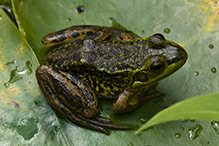 |
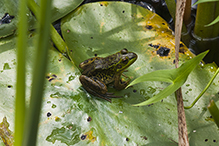 |
|
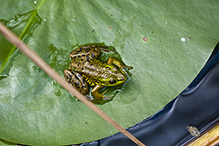 |
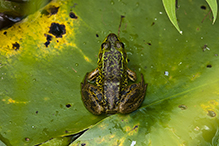 |
|
 |

Visitor Videos |
||
Share your video of this amphibian. |
||
This button not working for you? |
||
|
Other Videos |
||
Mink Frog (Rana septentrionalis) |
About
Published on Apr 30, 2012 No description available. |
Mink Frog |
About
Published on Oct 7, 2013 In this video, a Mink Frog (Rana septentrionalis) is shown by the shore of Kiwassa Lake in the rain. The Mink Frog is classified by some authorities, including the International Union for the Conservation of Nature (IUCN), under the scientific name Rana septentrionalis. This, however, is not widely accepted. The Mink Frog is a largely aquatic species of frog found in the northern United States and Canada. They rarely leave the water, unless during or after heavy rain. In this circumstance, it was raining fairly heavily, so I guess I got lucky. The Mink Frog gets its name from the mink, as they smell alike. The Mink Frog is assessed as being of least concern by the IUCN Red List of Threatened Species. This video was recorded on the Department of Environmental Conservation (DEC) owned shore of Kiwassa Lake in New York on August 31, 2013. |
Mink frogs calling |
About
Uploaded on Mar 19, 2009 Mink frogs calling in a Minnesota lake |

Visitor Sightings |
||
Report a sighting of this amphibian. |
||
This button not working for you? |
||
|
|
MinnesotaSeasons.com Sightings |
||

Created: 10/16/2012 Last Updated: © MinnesotaSeasons.com. All rights reserved. |
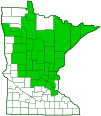
![Rana [Lithobates] septentrionalis](https://c1.staticflickr.com/6/5589/14596005965_b6606154f5.jpg)
